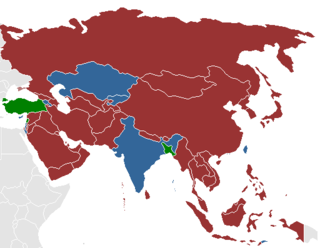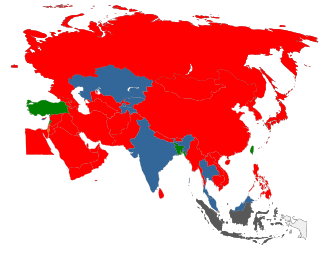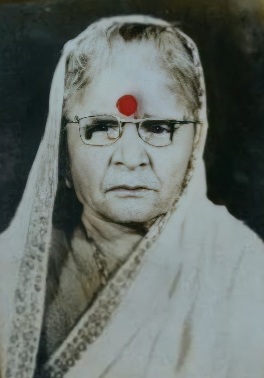
A brothel, bordello, ranch, or whorehouse is a place where people engage in sexual activity with prostitutes. However, for legal or cultural reasons, establishments often describe themselves as massage parlors, bars, strip clubs, body rub parlours, studios, or by some other description. Sex work in a brothel is considered safer than street prostitution.

Mumbai Central is a major railway station on the Western line, situated in Mumbai, Maharashtra in an area known by the same name. It serves as a major stop for both Local and Inter-City/Express trains with separate platforms for them. It is also a terminal for several long-distance trains including the Mumbai Rajdhani Express. It is one of the five major Terminal stations in Mumbai while others being Mumbai CST, Mumbai LTT, Mumbai BDTS and Mumbai Dadar. Trains depart from the station connecting various destinations mostly across states in the northern, western and north-western parts of India. The station was renamed from Bombay Central to Mumbai Central in 1997, following the change of Bombay to Mumbai. In 2018, a resolution was passed to change the station code to MMCT, with implementation ongoing.
Sonagachi is a neighbourhood in Kolkata, India, located in North Kolkata near the intersection of Jatindra Mohan Avenue with Beadon Street and Sovabazar, about one kilometer north of the Marble Palace area. Sonagachi is among the largest red-light districts in Asia and the world with several hundred multi-storey brothels residing more than 16,000 commercial sex workers.

Prostitution is legal in India, but a number of related activities including soliciting, kerb crawling, owning or managing a brothel, prostitution in a hotel, child prostitution, pimping and pandering are illegal. There are, however, many brothels illegally operating in Indian cities including Mumbai, Delhi, Kolkata, Pune, and Nagpur, among others. UNAIDS estimate there were 657,829 prostitutes in the country as of 2016. Other unofficial estimates have calculated India has roughly 3–10 million prostitutes. India is widely regarded as having one of the world's largest commercial sex industry. It has emerged as a global hub of sex tourism, attracting sex tourists from wealthy countries. The sex industry in India is a multi-billion dollar one, and one of the fastest growing.
Sanlaap is an Indian feminist non-governmental organisation, established by Indrani Sinha in 1987 in Calcutta. Based in Calcutta, the group aims to protect the human rights of women and girls. Sanlaap is a developmental organisation that works towards correction of social imbalances which present themselves as gender injustice and violence against women and children. The primary work is focused against trafficking of women and children for commercial sexual exploitation, sexual abuse and forced prostitution. As part of its work, the group starts shops to train girls to make a living and foster their independence.
Tulasa Thapa was a Nepali girl who was kidnapped from her home village of Thankot near Kathmandu in 1982 at the age of 13, smuggled into Mumbai via the border town of Birganj in Parsa District, and sold into prostitution. She was systematically beaten into submission, then repeatedly raped to make her fit for the trade. She was sold to three different brothels in Mumbai, at prices ranging from 5000 to 7000 rupees. In addition to the sex work she was forced to do in the brothel at a minimum of three customers per night, she was sent to various city hotels dressed in European style clothes to entertain customers for 180 rupees per night until at last a hotel manager reported her to the police. Following the public outcry, the governments of India and Nepal signed a 1985 cooperation agreement addressing the rescue and repatriation of Nepali girls trafficked into brothels in India.
Budhwar Peth is one of many commercial localities in the old city of Pune, India. The area is located in the heart of the city has a high number of electronics shops, and is known for its red-light district. Three out of the five important Ganesh Mandals i.e. Jogeshwari Ganpati, Guruji Talim Mandal, Tulshibaug Ganpati are located here, as is Appa Balwant Chowk, known as ABC.
Forced prostitution, also known as involuntary prostitution or compulsory prostitution, is prostitution or sexual slavery that takes place as a result of coercion by a third party. The terms "forced prostitution" or "enforced prostitution" appear in international and humanitarian conventions, such as the Rome Statute of the International Criminal Court, but have been inconsistently applied. "Forced prostitution" refers to conditions of control over a person who is coerced by another to engage in sexual activity.
Prostitution in Myanmar is illegal, but widespread. Prostitution is a major social issue that particularly affects women and children. UNAIDS estimate there to be 66,000 prostitutes in the country.
Prostitution in Kolkata is present in different forms and Kolkata's sex industry is one of the largest in Asia. Prostitution may be brothel-based or non-brothel based as in the case of call girls. India is regarded as having one of the largest commercial sex trades globally. Kolkata has many red-light districts, out of which Sonagachi is the largest red-light district in Asia with more than 50,000 commercial sex workers.

Prostitution in Pakistan is a taboo culture of sex-trade that exists as an open secret but illegal. Prostitution is largely based in organisational setups like brothels or furthered by individual call girls.

Prostitution is legal and regulated in Bangladesh. Prostitutes must register and state an affidavit stating that they are entering prostitution of their own free choice and that they are unable to find any other work. Bangladeshi prostitutes often suffer poor social conditions and are frequently socially degraded.
Prostitution in Suriname is illegal but widespread and the laws are rarely enforced. Human trafficking and Child prostitution are problems in the country. Prostitutes are known locally as "motyo". UNAIDS estimate there to be 2,228 prostitutes in the country.
G.B. Road,Garstin Bastion Road, is a road running from Ajmeri Gate to Lahori Gate in Delhi, India. It is a large red-light district. It has several hundred multi-storey brothels and there are estimated to be over 1,000 sex workers. It is lined with two or three-storey buildings that have shops on ground floor. About twenty of these buildings have about 100 brothels on the first floor that open at night after the shops at ground level close. It is the biggest red light area in Delhi.
Kamathis are a group of people from Mumbai, India who had migrated to the city from the Indian state of Hyderabad state. In 1795, the Maratha army defeated the Nizam of Hyderabad. Following this, many artisans and construction workers from Telangana migrated to Bombay and settled into the flats which were made livable by the construction of the Hornby Vellard. These workers where called Kamathis, and their enclave was called Kamathipura.
Human trafficking in India, although illegal under Indian law, remains a significant problem. People are frequently illegally trafficked through India for the purposes of commercial sexual exploitation and forced/bonded labour. Although no reliable study of forced and bonded labour has been completed, NGOs estimate this problem affects 20 to 65 million Indians. Men, women and children are trafficked in India for diverse reasons. Women and girls are trafficked within the country for the purposes of commercial sexual exploitation and forced marriage, especially in those areas where the sex ratio is highly skewed in favour of men. Men and boys are trafficked for the purposes of labour, and may be sexually exploited by traffickers to serve as gigolos, massage experts, escorts, etc. A significant portion of children are subjected to forced labour as factory workers, domestic servants, beggars, and agriculture workers, and have been used as armed combatants by some terrorist and insurgent groups.

Prostitution has been practiced throughout ancient and modern cultures. Prostitution has been described as "the world's oldest profession," although the oldest professions are most likely farmers, hunters, and shepherds.

The practice of prostitution in colonial India was influenced by the policies of British rule in India. During the 19th and 20th centuries the colonial government facilitated, regulated and allowed the existence of prostitution. Not only was prostitution in India affected by the policy of the Governor General of India, it was also influenced by the moral and political beliefs of the British authorities, and conflicts and tensions between the British authorities and the Indian populace at large. The colonial government had a profound effect on prostitution in India, both legislatively and socially.

Mumbai, is a city in India which contains the neighborhood of Kamathipura, one of the largest red-light districts in Asia. India is regarded as having one of the largest commercial sex trades globally. These neighborhoods are so large and popular that Mumbai has been called the "ultimate destination" for sex tourism. The red-light districts or lal bazaars in Mumbai are inhabited by thousands of sex workers including women, men, children, and transgender people.

Gangubai Harjeevandas, better known as Gangubai Kothewali or Gangubai Kathiawadi, was an Indian social activist, prostitute and madam of a brothel in the Kamathipura area of Mumbai during the 1960s. Gangubai worked for the rights of sex-workers and for the well-being of orphans. She gradually ended up operating her own brothel and is known to also have lobbied for the rights of commercial sex workers.















